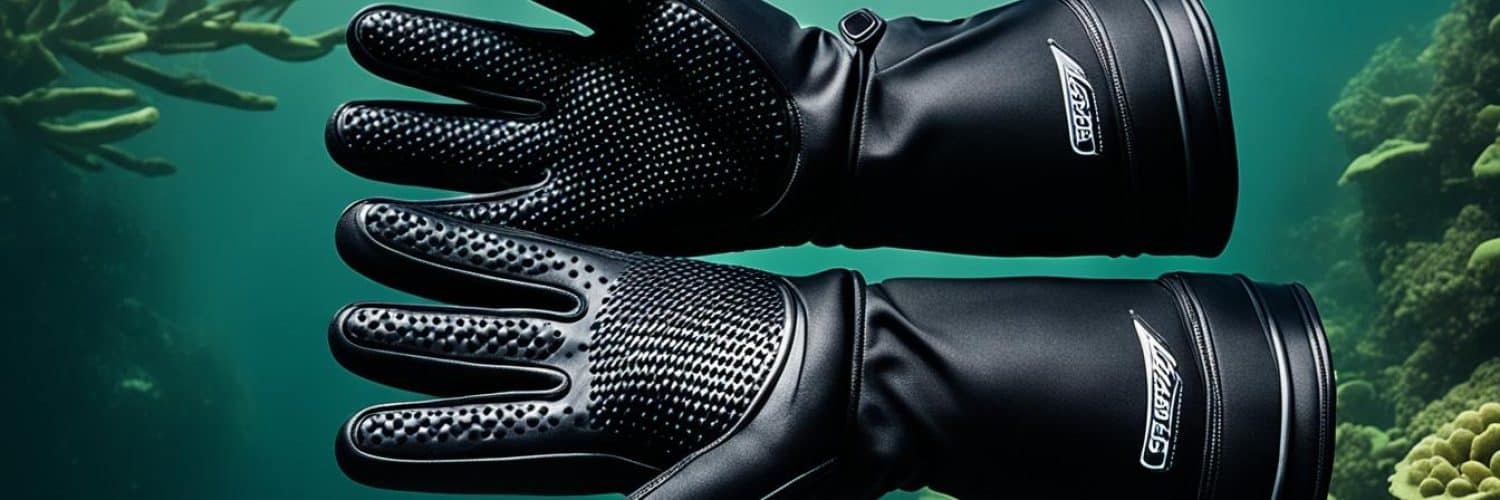Diving gloves are an essential piece of equipment for anyone venturing into the underwater world. Not only do they provide protection against sharp surfaces and potential stings from marine life, but they also offer thermal insulation to keep your hands warm in cold water.
In this comprehensive guide, we will explore the different types of diving gloves available, the materials they are made from, and the factors to consider when choosing the right pair for your diving adventures. So, whether you’re an avid diver or just starting out, let’s dive in and discover the top diving gloves that will enhance your underwater grip and overall diving experience.
Key Takeaways:
- Diving gloves offer protection against sharp surfaces and marine life.
- They provide thermal insulation to keep your hands warm in cold water.
- There are different types of diving gloves for various diving conditions.
- Materials used in diving gloves include fabric and neoprene.
- Consider factors such as thermal protection and dexterity when selecting diving gloves.
Benefits and Drawbacks of Diving Gloves
Diving gloves offer a range of benefits and drawbacks that divers should consider when choosing their gear. These gloves provide essential protection against cuts, scrapes, and stings from marine life, ensuring a safe and enjoyable diving experience. Additionally, diving gloves offer thermal insulation, keeping hands warm in cold water environments. This is especially important for divers exploring chilly dive sites or participating in long dives.
However, it is important to note that diving gloves can reduce dexterity, making certain tasks more difficult. The thick material of the gloves can limit finger movement and tactile sensitivity, affecting the diver’s ability to handle equipment or perform delicate tasks underwater. It is crucial to maintain a good grip and be mindful of potential limitations caused by reduced dexterity while wearing diving gloves.
Moreover, wearing diving gloves should not be a license to touch the marine environment indiscriminately. It is vital to respect the fragile underwater ecosystem and avoid any unnecessary contact while diving. Interacting with marine life should be done responsibly and consciously, taking into consideration the potential impact on the delicate balance of the underwater ecosystem. Touching, grabbing, or disturbing marine creatures can harm both them and their habitat.
To summarize, diving gloves offer protection against cuts, scrapes, and stings, as well as thermal insulation. However, they can restrict dexterity and should not be used as an excuse for reckless behavior. Divers should strike a balance between enjoying the benefits of diving gloves and respecting the marine environment.
“Wearing diving gloves allows divers to explore underwater environments with a sense of security and warmth, but it’s important to remember that we are visitors in the underwater realm.”
Pros and Cons of Diving Gloves
| Benefits | Drawbacks |
|---|---|
| Protection against cuts, scrapes, and stings | Reduced dexterity |
| Thermal insulation in cold water | Limitations in handling equipment and performing delicate tasks |
| Potential risk of touching and disturbing the marine environment |
Types of Diving Gloves
When it comes to diving gloves, there are various types available, each specifically designed to cater to different diving conditions. Whether you’re diving in warm-water or cold-water environments, there’s a glove that suits your needs. Let’s explore the different types of diving gloves:
1. Warm-Water Gloves
Warm-water gloves are perfect for divers exploring tropical or temperate waters. These gloves are lightweight, providing excellent protection while prioritizing dexterity. They allow you to maintain a good grip on your equipment and maneuver through the water with ease.
2. Cold-Water Gloves
For diving in colder climates, cold-water gloves offer superior insulation to keep your hands warm even in frigid waters. These gloves come in various designs, including the conventional 5-finger gloves, 3-finger gloves, and mitten-style gloves. The choice of design depends on personal preference and the level of dexterity required for your dive.
3. Diving Mittens
Diving mittens provide a unique option for divers who prioritize warmth over individual finger mobility. These gloves are designed as one enclosed space for all your fingers, maximizing heat retention in extremely cold-water environments.
4. Dry Gloves
Dry gloves are specially designed to keep your hands completely dry during your dive. These gloves feature an airtight seal around the wrist, which prevents water from entering the glove. Dry gloves are commonly used in extremely cold-water diving, where maintaining dry hands is crucial to avoid the risk of hypothermia.
5. Webbed Paddle Gloves
Webbed paddle gloves are an excellent choice for divers with mobility limitations or disabilities. These gloves have webbing between the fingers, allowing for increased hand mobility and acting like small paddles, providing enhanced propulsion through the water.
Choosing the right type of diving glove depends on the specific diving conditions you’ll be facing. Consider the water temperature, the level of dexterity required, and any additional mobility needs before making your selection.
Materials Used in Diving Gloves
When it comes to diving gloves, the right choice of materials can make all the difference in terms of comfort, flexibility, and performance. Let’s explore two popular options: fabric gloves and neoprene gloves.
Fabric Gloves
Fabric gloves are known for their exceptional freedom of movement and touch sensitivity, making them a top choice for divers who prioritize dexterity. These gloves are typically made from a blend of synthetic materials such as nylon, spandex, and elastane, offering a snug fit that allows for precise movements and a secure grip.
One of the key advantages of fabric gloves is their lightweight design, which provides divers with a natural feel and increased tactile feedback. This is especially important when handling delicate equipment or performing intricate tasks underwater. Fabric gloves also dry quickly, minimizing the risk of discomfort caused by prolonged wetness.
However, it’s worth noting that fabric gloves may not provide the same level of thermal insulation as neoprene gloves. Therefore, they are more suited for warm-water diving conditions where cold protection is not the primary concern.
Neoprene Gloves
Neoprene gloves are renowned for their thermal insulation and durability. Neoprene, a synthetic rubber material, traps a thin layer of water between the glove and the skin. This water is then warmed by body heat, creating a barrier against the cold temperatures encountered during diving.
In addition to thermal insulation, neoprene gloves offer excellent resistance to wear and tear, making them ideal for divers who frequently explore rugged underwater environments. These gloves often feature reinforced palms and fingertips to enhance grip and protect against abrasion.
Some neoprene gloves also incorporate supplemental materials to enhance specific characteristics. For example, kevlar may be added to provide additional protection against sharp objects, while titanium may be infused to improve warmth.
Overall, neoprene gloves are suitable for a wide range of diving conditions, including cold-water diving where thermal protection is crucial.
Comparison Table: Fabric Gloves vs. Neoprene Gloves
| Features | Fabric Gloves | Neoprene Gloves |
|---|---|---|
| Freedom of Movement | Excellent | Good |
| Touch Sensitivity | High | Moderate |
| Thermal Insulation | Low | High |
| Durability | Moderate | High |
| Additional Materials | None | Kevlar, Titanium, etc. |
Now that you have a better understanding of the materials used in diving gloves, you can make an informed decision based on your diving needs and preferences. Whether you prioritize dexterity or thermal insulation, there are options available to suit every diver’s requirements.
Considerations for Selecting Diving Gloves
Choosing the right diving gloves is crucial for a comfortable and safe underwater experience. When selecting diving gloves, three key factors to consider are thermal protection, glove thickness, and dexterity.
Thermal protection is essential, especially when diving in different water temperatures. To determine the appropriate level of insulation, understanding the water conditions is vital. Lightweight fabric gloves are well-suited for warm water, providing flexibility and dexterity without compromising thermal protection. On the other hand, for cold-water diving, neoprene gloves ranging from 5-7 mm in thickness offer excellent insulation.
Glove thickness is directly related to thermal protection. For warm-water conditions, a thinner glove, approximately 1-3 mm in thickness, usually suffices. It allows for better dexterity and greater tactile feedback, enabling efficient gear operation underwater. In contrast, for colder temperatures, a thicker glove with greater insulation is necessary to prevent heat loss and keep hands warm.
Dexterity plays a crucial role in diving activities, as it enables divers to manipulate equipment, handle dive lights, and perform various tasks underwater. While thicker gloves offer better insulation, they may restrict finger movements, reducing dexterity. To strike a balance between warmth and flexibility, consider gloves designed with anatomical shaping and pre-curved fingers, enhancing dexterity without compromising thermal protection.
| Factors to Consider | Key Considerations |
|---|---|
| Thermal Protection | Choose glove thickness based on water temperature |
| Glove Thickness | Thicker gloves for colder water; thinner gloves for warmer water |
| Dexterity | Consider gloves with anatomical shaping and pre-curved fingers for enhanced dexterity |
Remember, selecting diving gloves that provide optimal thermal protection, appropriate glove thickness, and dexterity is essential for an enjoyable and safe diving experience.
Product Options for Diving Gloves
When it comes to diving gloves, there is a wide range of options available to suit the preferences and needs of divers. Some popular brands in the market include Scubapro, XUKER, XS Scuba, and SEAC, among others. These brands offer a variety of diving gloves with different features and capabilities.
Diving gloves from these reputable brands are designed to provide superior grip, ensuring that divers can maintain a secure hold on their equipment and surfaces underwater. The gloves often feature textured palms or fingers to enhance grip and prevent slips, even in wet conditions.
Another important feature to consider in diving gloves is an adjustable wrist closure. This allows divers to customize the fit and prevent water from entering the gloves, ensuring a comfortable and dry experience. It also helps to keep the gloves securely in place during underwater activities.
Thermal linings are also a key consideration, especially for divers exploring colder waters. Many diving gloves come with thermal linings that provide additional insulation, keeping hands warm and comfortable even in chilly conditions. This is particularly important for divers who spend extended periods underwater.
Durability is another factor to look for when choosing diving gloves. The gloves should be able to withstand the harsh underwater environment, including potential abrasions from rocks, coral, or marine life. Diving gloves made from high-quality materials, such as neoprene, are known for their durability and long-lasting performance.
For divers who want to make informed purchasing decisions, there are numerous online platforms that provide product reviews and prices for diving gloves. These reviews offer insights from other divers who have already tested the gloves, giving potential buyers a better understanding of their performance and suitability for different diving conditions.
Overall, the product options for diving gloves are vast, allowing divers to find the perfect pair that meets their specific needs. From brands like Scubapro to XUKER, XS Scuba, and SEAC, there are choices for every diver, offering superior grip, adjustable wrist closures, thermal linings, and durable construction.
Pro Tips and Recommendations for Warm-Water Divers
While choosing specific warm-water diving gloves is essential for optimal performance, warm-water divers can also consider well-fitting work gloves as a more budget-friendly alternative. Work gloves offer decent protection and dexterity, making them suitable for less demanding warm-water dives.
Pro Tip: As an affordable option, warm-water divers can use work gloves with good grip and protection. However, ensure the gloves are comfortable, fit snugly, and provide adequate tactile feedback for a safe and enjoyable diving experience.
When selecting work gloves for warm-water diving, the 3M Comfort Grip gloves are highly recommended. These gloves are designed with the diving enthusiast in mind and offer exceptional benefits:
- Excellent Grip: The 3M Comfort Grip gloves feature a specialized coating that enhances grip, ensuring a secure hold on equipment and surfaces.
- Abrasion Protection: Made with durable materials, these gloves provide protection against abrasions, safeguarding your hands during underwater exploration.
- Smartphone Compatibility: With their touchscreen compatibility, you can conveniently operate your mobile phone without having to remove the gloves.
Before opting for work gloves, it’s crucial to consider the specific needs of your warm-water dives and weigh the advantages and disadvantages compared to dedicated warm-water diving gloves. While the right pair of warm-water diving gloves offers specialized features and enhanced performance, work gloves can provide a more budget-friendly option without compromising on essential functionalities.
| Feature | 3M Comfort Grip gloves |
|---|---|
| Excellent Grip | ✓ |
| Abrasion Protection | ✓ |
| Smartphone Compatibility | ✓ |
Importance of Dexterity and Tactile Feedback
Maintaining manual dexterity and tactile feedback is crucial for safe and effective diving. When exploring the underwater world, divers rely on their hands for various tasks such as adjusting equipment, securing objects, and communicating through hand signals. Nimble fingers are essential for proper gear operation and quick responses to unexpected situations.
Gloves with flexible neoprene, like the Scubapro Everflex Dive Gloves, are designed to enhance finger dexterity while providing protection and insulation. The neoprene material offers excellent flexibility, allowing divers to maintain a firm grip on their equipment and perform intricate tasks underwater. These gloves also provide tactile feedback, allowing divers to sense the texture and temperature of objects they come into contact with.
The Scubapro Everflex Dive Gloves
The Scubapro Everflex Dive Gloves are specifically engineered to balance warmth, flexibility, and dexterity. The 3mm thick neoprene material provides sufficient insulation without sacrificing tactile sensitivity. With textured palm and fingers, these gloves offer exceptional grip, ensuring that objects do not slip from your hands while diving. The adjustable wrist closure ensures a secure fit, minimizing water entry. Whether you are a recreational diver or a professional underwater photographer, these gloves are an excellent choice to enhance your diving experience.
Conclusion
Choosing the right diving gloves is crucial for ensuring a comfortable and safe diving experience. When considering which diving gloves to invest in, it’s important to take into account factors such as thermal protection, dexterity, and materials.
Thermal protection is essential, especially in colder waters, so make sure to select gloves with the appropriate level of insulation. Diving gloves made from neoprene are a popular choice as they offer both thermal protection and durability.
Additionally, prioritize dexterity as it allows for effective handling of equipment and communication through hand signals. Look for diving gloves that offer the flexibility and finger dexterity required for maneuverability.
Ultimately, the best diving gloves are those that provide the necessary warmth and flexibility without compromising safety. Consider your specific needs and preferences when selecting the ideal pair of diving gloves for you.
FAQ
Why are diving gloves essential for underwater exploration?
Diving gloves offer protection against sharp surfaces and provide thermal insulation, keeping your hands safe and warm while diving.
What are the benefits of wearing diving gloves?
Diving gloves provide protection against cuts, scrapes, and stings from marine life, as well as thermal insulation to keep your hands warm in cold water.
Do diving gloves affect dexterity?
Yes, diving gloves can reduce dexterity, making certain tasks more difficult. It’s important to avoid touching the marine environment while wearing diving gloves.
What are the different types of diving gloves?
There are warm-water gloves, cold-water gloves (including 5-finger, 3-finger, and mitten designs), dry gloves, and webbed paddle gloves available for different diving conditions.
What materials are diving gloves made from?
Diving gloves are made from various materials, such as fabric gloves that offer freedom of movement and touch sensitivity, and neoprene gloves that provide thermal insulation and durability.
What factors should I consider when selecting diving gloves?
It’s important to consider the level of thermal protection needed based on water temperatures, as well as glove thickness and dexterity for effective gear operation.
What are some product options for diving gloves?
There are numerous options available from brands like Scubapro, XUKER, XS Scuba, and SEAC, offering features such as grip, adjustable wrist closures, thermal linings, and durable construction. Reviews and prices can be found online.
Are there alternatives to expensive diving gloves for warm-water divers?
Yes, well-fitting work gloves like the 3M Comfort Grip gloves can be used as an alternative. They provide excellent grip and protection from abrasion, allowing you to operate a mobile phone while wearing them.
Why is dexterity important for diving?
Maintaining manual dexterity and tactile feedback is crucial for safe and effective diving. Gloves with flexible neoprene, like the Scubapro Everflex Dive Gloves, provide improved finger dexterity and tactile feedback.
How do I choose the best diving gloves?
When choosing diving gloves, consider factors like thermal protection, dexterity, and materials. Ensure the gloves provide the necessary warmth and flexibility without compromising safety.







Add comment